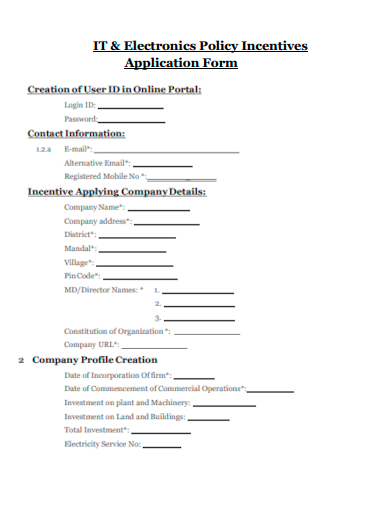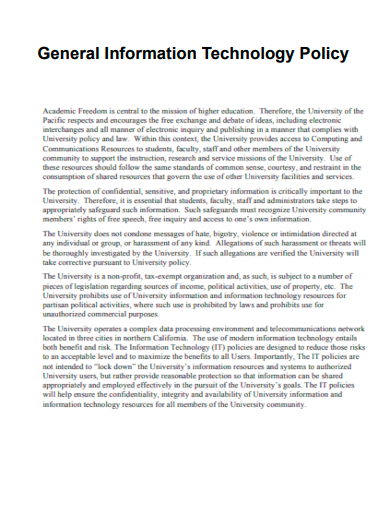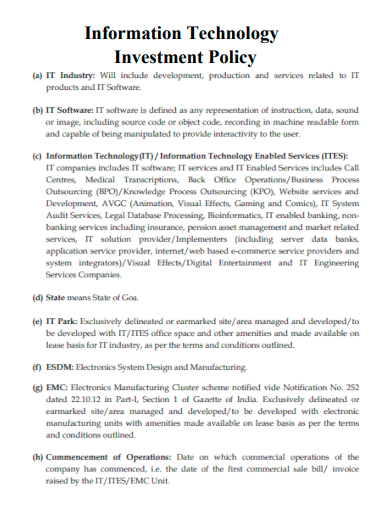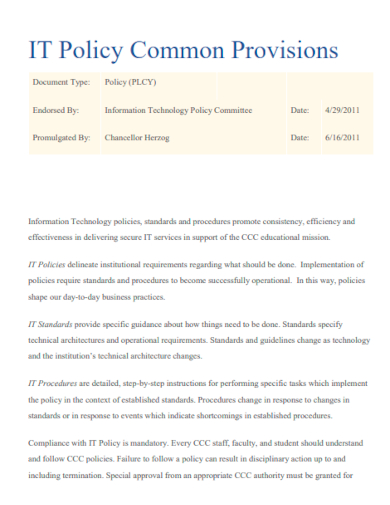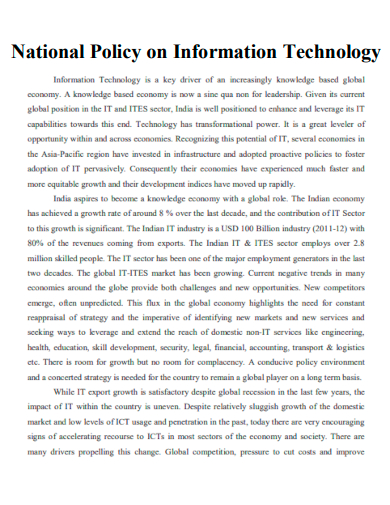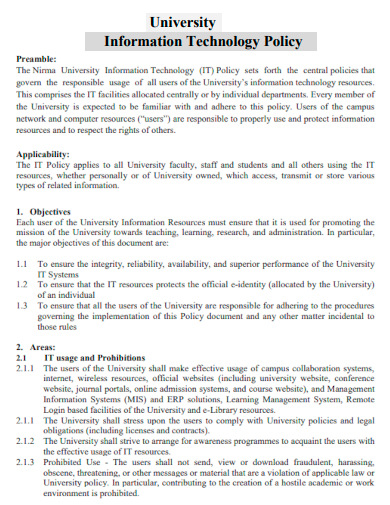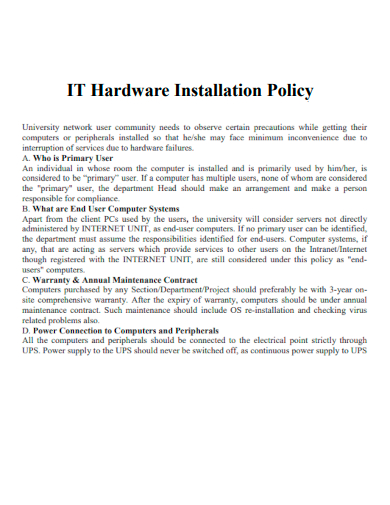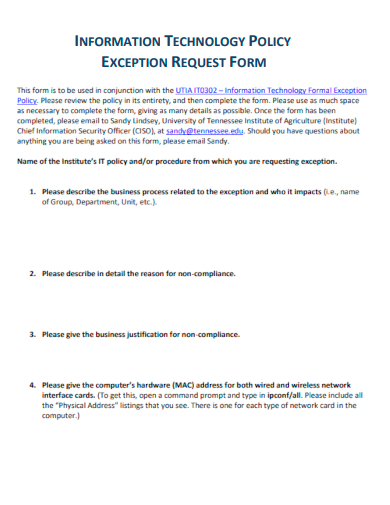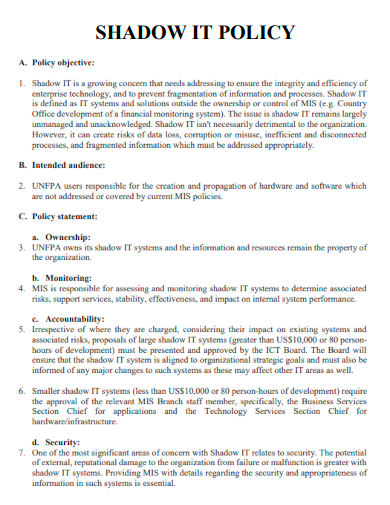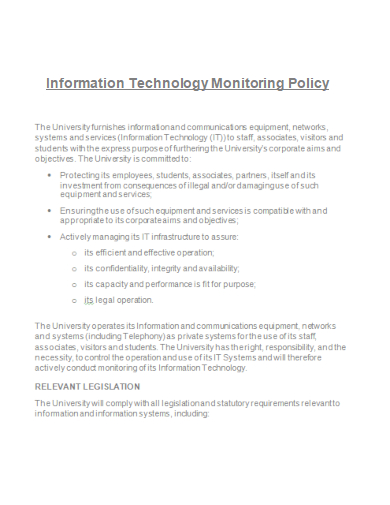Over the last year, the IT sector has altered dramatically. While security threats have increased dramatically, we’ve also seen considerable interruptions in other areas of IT. For example, the abrupt shift to remote and hybrid working settings has produced new challenges in terms of effective IT product usage, value creation, service delivery, efficiency, and so on. You’ll need an action roadmap of sorts to bring order to this turmoil, setting clear IT management standards that correspond with your business goals. To assist you with many elements such as data security, IT management, standards for data use, security awareness, business continuity, and more, clear rules in the form of IT processes and regulations must be set.
10+ IT Policy Samples
IT policies and procedures create rules for an organization’s usage of information technology. In other words, it spells out what employees are supposed to do with business assets. You can adopt actions that are consistent, effective, and efficient with the support of good policies and procedures. Documented rules and procedures can outline how you integrate and manage technology in your organizational environment, in addition to helping you address security concerns by raising awareness. We all know how tedious it is to read, let alone draft, policies. They are, nonetheless, a necessary foundation for establishing your IT operations and administration. It is not necessary for your Information Technology (IT) Policy statement to be elaborate, too technical, or pedantic.
1. IT & Electronics Policy Incentives Application Form
2. General Information Technology Policy
3. Information Technology Investment Policy
4. IT Policy Common Provisions
5. National Policy on Information Technology
6. University Information Technology Policy
7. IT Hardware Installation Policy
8. Information Technology Policy Exception Request Form
9. Information Technology Security Policy
10. Shadow IT Policy
11. Information Technology Monitoring Policy
Policies an IT Department Should Have
There are several policies pertaining to a company’s IT department. An IT department ought to have clear procedures in place for everything from managing multiple IT assets to guaranteeing data security. The following are some of the important policies that apply to IT departments:
IT Asset Management Policy
These policies spell out the rules that must be followed when it comes to an institution’s IT assets. It should have defined protocols governing which assets are permitted for various tasks. You’ll also need a BYOD (bring your own device) policy, which specifies whether employees are permitted to access to the network using their own devices.
IT Software Management Policy
These policies assist businesses in properly managing their software tools. You need thorough policies that detail the appropriate use of the program, from providing the list of allowed tools to software automation. Patching rules must also be prioritized to ensure that all of your software tools are upgraded on time.
IT Security Policy
Information security, password protection, remote access, and security training are all facets of IT security. Both risk prevention and harm mitigation require robust policies. You should also provide frequent training to your personnel to ensure that security initiatives are carried out properly.
IT Emergency Response Policy
How you respond to a security breach can make or ruin your company. Incident response, continuity management, backup and recovery, and data encryption policies are all required. You can limit the harm caused by a breach and quickly restart operations if you have a solid incident response plan in place.
IT Employment Policy
For IT workers, relevant rules should be formulated and executed. Above all, it should establish clear expectations for what must be accomplished in their unique job duties. Regular training, responsibilities, access to vital information, performance, and other policies must all be set. This assists you in managing your employees’ daily performance targets.
FAQs
Who is responsible for policies and procedures in an organization?
Policies are often formed in accordance with an organization’s vision and objectives. IT managers develop IT policies, which are managed by IT administrators in an organization. However, determining policies is a collaborative activity that involves input from a variety of stakeholders within the business. The HR department plays a key role in making it a company-wide policy, collaborating with managers from other departments to ensure its implementation.
Why is it important to review policies and procedures?
In any organization, drafting IT policy is not a one-time task. Over time, several changes are likely to occur. The business could grow and become a larger corporation. In the current context, the policies that were once religiously obeyed may be irrelevant. As a result, it is critical to review IT rules and procedures on a frequent basis. Your analysis should cover technical advancements, organizational policy shifts, corporate objectives, and more. You can make adjustments to your policy based on the input.
An IT policy’s most significant characteristic is that it is a living document. As a result, you must ensure that the IT Policy document does not become a one-time project that collects dust or is lost in a distant folder. Include training sessions and refresher courses in your policy document, and involve the entire organization in improving and reviewing it on a regular basis, at least once every six months. After each IT policy training or workshop, have all attendees sign a copy of the policy as an acknowledgement of their understanding of the policy.
Related Posts
FREE 10+ Related Personnel Policy Samples in MS Word | PDF
FREE 10+ Suspension And Expulsion Policy Samples in MS Word | PDF
FREE 10+ Student Travel Policy Samples in MS Word | Google Docs | Pages | MS Outlook | PDF
FREE 10+ Uniform Complaint Policy and Procedure Samples in PDF
FREE 10+ Bullying Policy Samples in MS Word | PDF
FREE 10+ Fiscal Control Policy Samples & Templates in MS Word | PDF
FREE 10+ Cooperative Policy Samples & Templates in MS Word | PDF
FREE 10+ Disenrollment Policy Samples in MS Word | PDF
FREE 10+ Donation Policy Samples & Templates in MS Word | PDF
FREE 10+ Homework Policy Samples & Templates in MS Word | Pages | PDF
FREE 10+ IT and Software Policy Samples in PDF | MS Word | Pages | Google Docs
FREE 50+ Policy Samples in PDF | MS Word
FREE 50+ Membership Policy Samples in PDF
FREE 10+ Shipping Policy Samples in PDF
FREE 10+ Expense Policy Samples in Word | Google Docs | Pages | PDF

